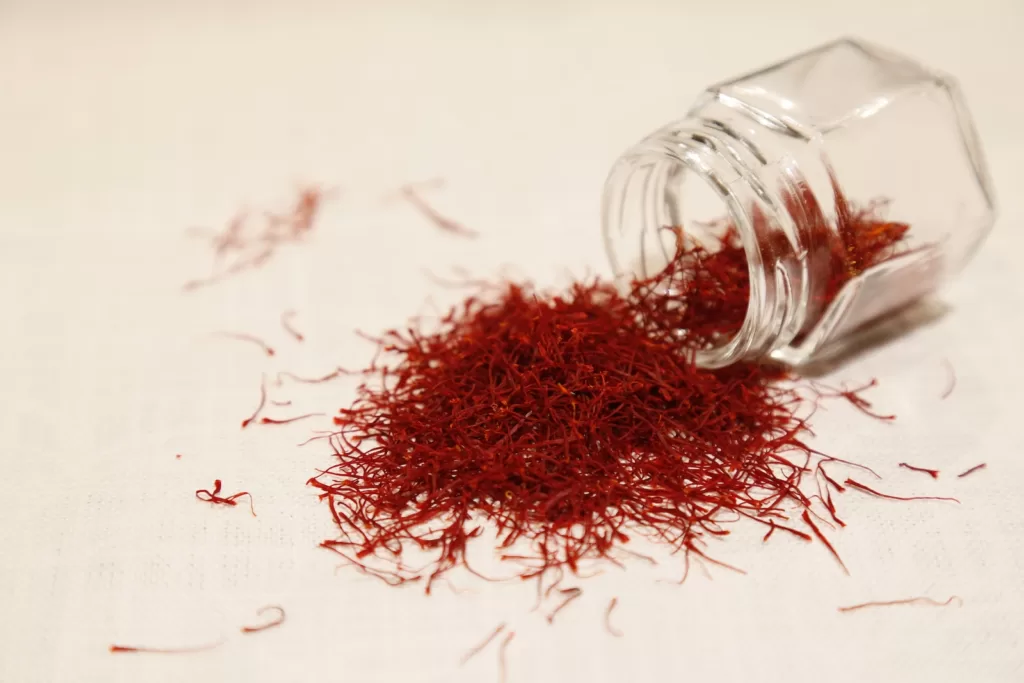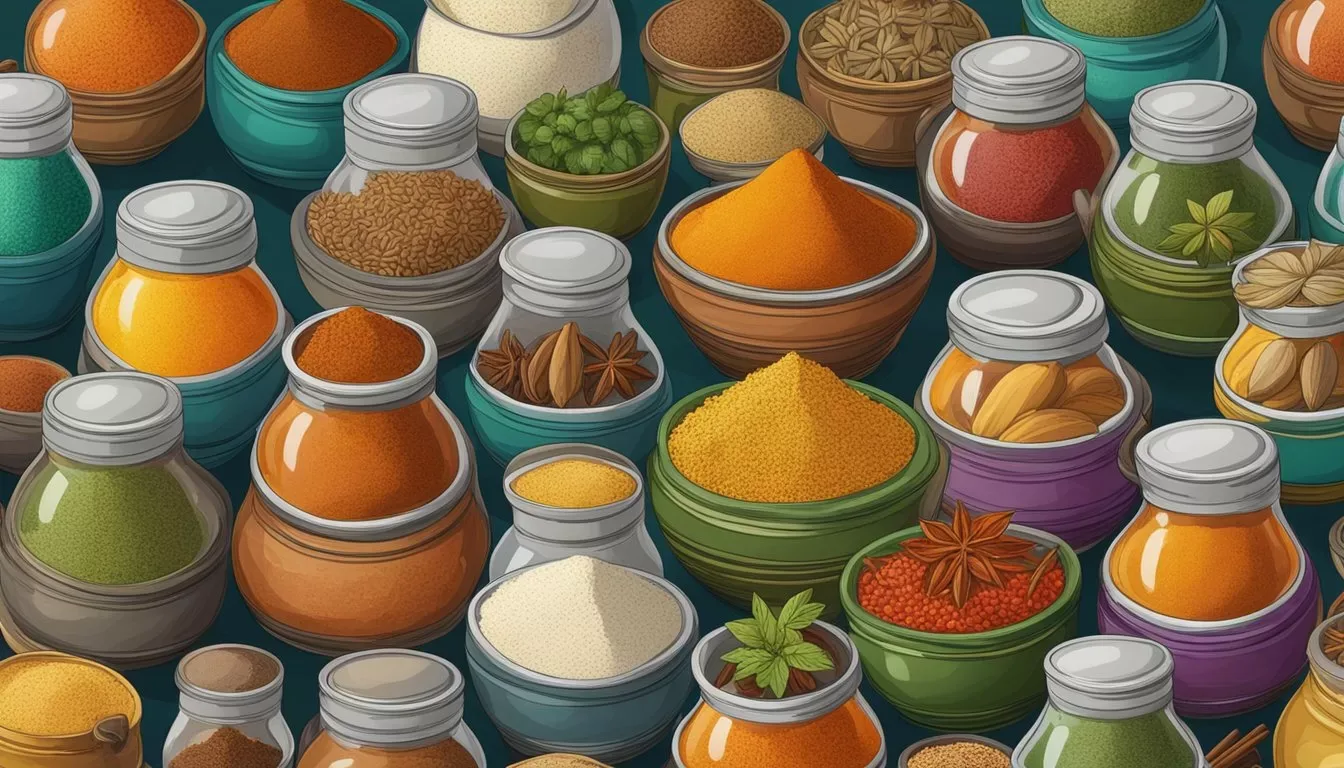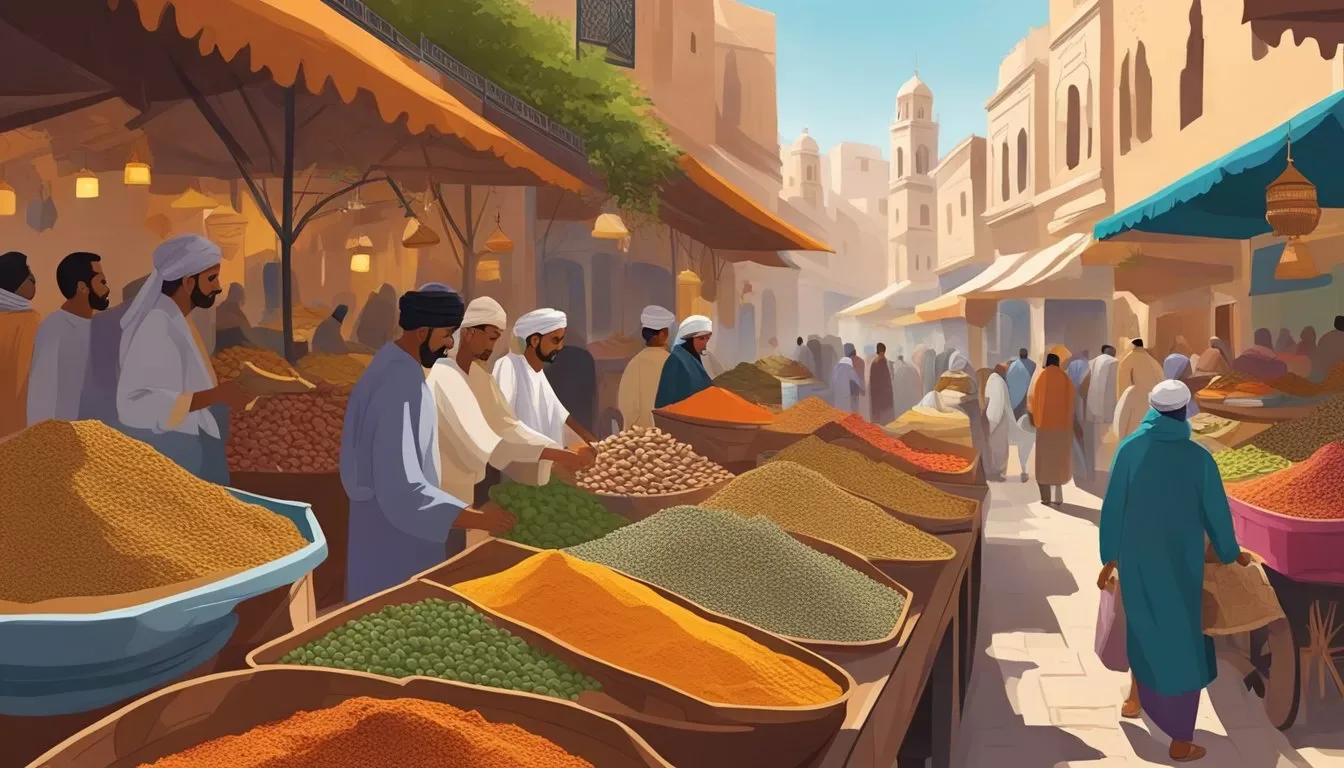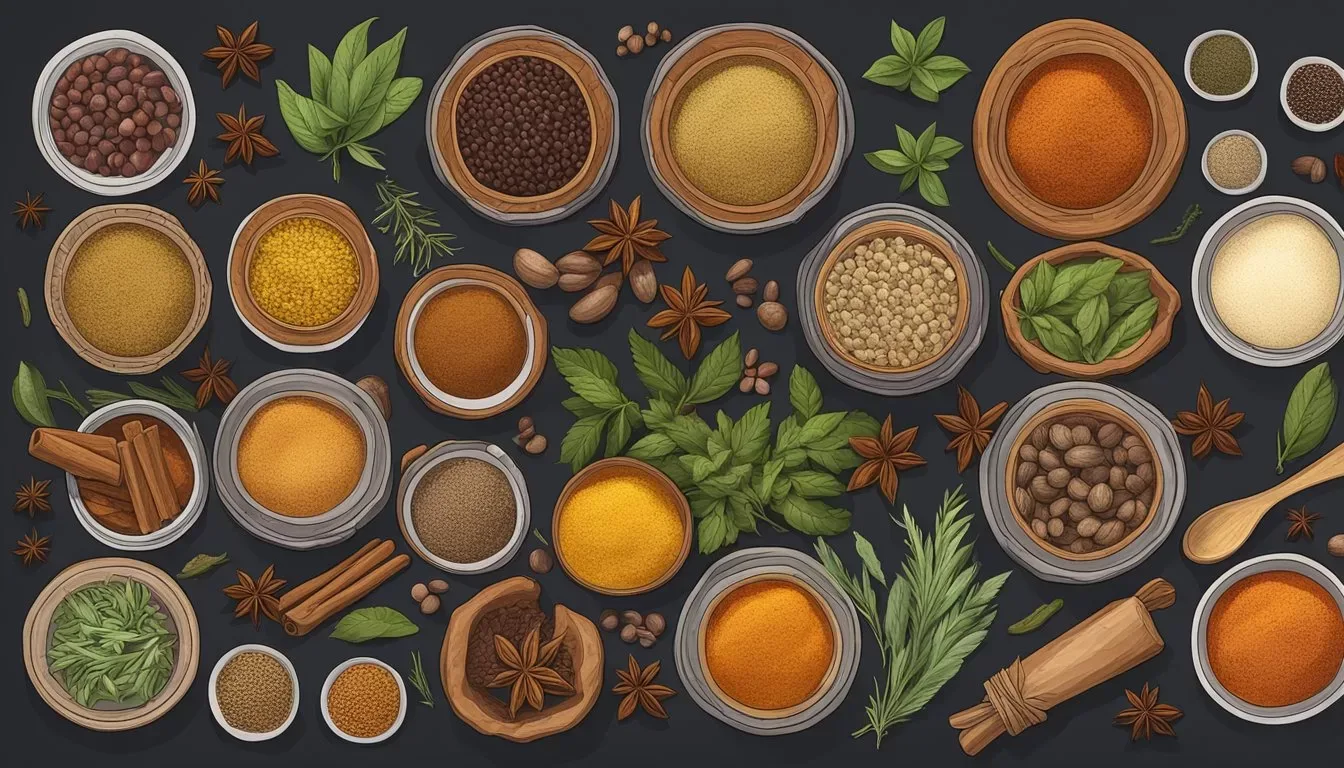Overview of Moroccan Spices and Herbs
Moroccan cuisine is famous for its bold and complex flavors, which are achieved through the use of a wide variety of herbs and spices. Moroccan spices and herbs are an essential part of the country’s culinary culture, and they play a vital role in defining the unique Moroccan flavor profile.
Traditional Moroccan Spices are a mix of spices that are commonly used in Moroccan cuisine. These spices include cumin, ginger, paprika, cinnamon, turmeric, and coriander. Each spice has its unique flavor and aroma, which contributes to the overall flavor profile of Moroccan dishes.
One of the most popular Moroccan Spice Blends is Ras el Hanout, which translates to “head of the shop.” It is a blend of up to 20 different spices, including cumin, coriander, ginger, and cinnamon. The exact combination of spices used in Ras el Hanout varies from region to region, and even from one spice merchant to another.
Moroccan flavor profile is characterized by a unique blend of sweet, savory, and spicy flavors. Moroccan cuisine often combines sweet and savory flavors, which can be seen in dishes like tagine, a slow-cooked stew made with meat, vegetables, and spices. Moroccan spices and herbs are also used to add heat to dishes, with spices like cayenne pepper and harissa paste being popular choices.
Here are some relevant facts about Moroccan Spices and Herbs:
- Moroccan cuisine has been influenced by a variety of cultures, including Arab, Berber, and Mediterranean.
- Many Moroccan spices and herbs have medicinal properties. For example, ginger is used to aid digestion, while saffron is believed to have anti-inflammatory properties.
- Moroccan cuisine is often served with bread, which is used to scoop up sauces and stews.
- Mint tea is a popular drink in Morocco and is often served after meals.
In summary, Moroccan spices and herbs are an essential part of the country’s culinary culture, and they play a vital role in defining the unique Moroccan flavor profile. From traditional Moroccan spices to popular spice blends like Ras el Hanout, Moroccan cuisine is full of bold and complex flavors that are sure to tantalize the taste buds.
Common Moroccan Spices and Their Uses

Moroccan cuisine is famous for its rich and exotic flavors, thanks in large part to the use of a wide variety of spices and herbs. From cumin to saffron to ras el hanout, each spice has its own unique flavor and aroma that brings life to traditional Moroccan dishes. In this section, we will explore some of the most common Moroccan spices and their uses.
Cumin in Moroccan Cooking
Cumin is a staple in Moroccan cuisine and is used in a variety of dishes such as tagine, couscous, and harira. It has a warm, earthy flavor and is also believed to aid in digestion. Cumin is often used in combination with other spices such as coriander and paprika to create a complex and flavorful blend.
Saffron in Morocco
Saffron is one of the most expensive spices in the world, and it is used sparingly in Moroccan cuisine due to its high cost. However, it is an essential ingredient in dishes such as paella and bouillabaisse. Saffron has a unique flavor and aroma that is both floral and earthy, and it adds a beautiful golden color to dishes.
Ras el Hanout Recipe
Ras el hanout is a spice blend that is widely used in Moroccan cuisine. It is made up of a variety of spices such as cumin, coriander, ginger, and cinnamon, and the number of spices in the blend can vary depending on the recipe. Ras el hanout literally means “head of the shop,” and it is said that each spice merchant has their own unique blend of the spice. Ras el hanout is used in dishes such as tagine, couscous, and grilled meats.
Tagine Seasoning
Tagine is a traditional Moroccan dish that is named after the earthenware pot in which it is cooked. Tagine seasoning typically includes a blend of spices such as cumin, coriander, paprika, ginger, and cinnamon. The spices are used to create a rich and flavorful sauce that is used to cook the meat and vegetables.
Moroccan cuisine is known for its bold and complex flavors, and the use of spices and herbs is a key component of this. From cumin to saffron to ras el hanout, each spice has its own unique flavor and aroma that brings life to traditional Moroccan dishes. By understanding the uses of these common Moroccan spices, you can bring the flavors of Morocco into your own kitchen.
Relevant Facts:
- Moroccan cuisine is heavily influenced by the country’s history as a major trading hub for spices and herbs.
- Some other common Moroccan spices include ginger, turmeric, and paprika.
- Many Moroccan spice blends contain more than ten different spices.
- Spices are often toasted before being ground to bring out their flavors.
- Moroccan cuisine is known for its use of preserved lemons, which are used in dishes such as tagine and couscous.

Table:
Here’s a table outlining some of the most famous spices and herbs.
| English Name | Arabic Name (Arabic Alphabet) | Flavor Profile | Common Uses |
|---|---|---|---|
| Cumin | كمون (Kammun) | Warm, earthy, slightly bitter | Stews, soups, spice blends, meats |
| Saffron | زعفران (Za’faran) | Sweet, floral, luxurious | Rice dishes, desserts, sauces |
| Cinnamon | قرفة (Qirfah) | Sweet, woody, aromatic | Desserts, pastries, spice blends, tea |
| Mint | نعناع (Na’na’) | Fresh, cool, slightly sweet | Teas, salads, garnishes, sauces |
| Coriander (seeds) | كزبرة (Kuzbara) | Nutty, citrusy, warm | Spice blends, curries, meats, vegetables |
| Parsley | بقدونس (Baqdunis) | Fresh, slightly peppery | Salads, garnishes, soups, sauces |
| Paprika | بابريكا (Babrika) | Sweet, mild, sometimes smoky | Meats, vegetables, stews, garnishes |
| Turmeric | كركم (Kurkum) | Earthy, slightly bitter, mustardy | Rice, stews, spice blends, soups |
| Cardamom | هال (Hāl) | Sweet, spicy, aromatic | Desserts, coffees, spice blends, rice |
| Thyme | زعتر (Za’atar) | Earthy, slightly minty, lemony | Za’atar blend, meats, breads, vegetables |
URLs to Link To:
Creating Moroccan Spice Mixes
Moroccan cuisine is known for its bold and exotic flavors, which are achieved through the use of a variety of spices and herbs. One of the most important aspects of Moroccan cooking is the use of spice blends, which are carefully crafted to bring out the unique flavors of each dish.
How to Make Traditional Moroccan Spice Blend at Home
If you want to create authentic Moroccan dishes at home, it is essential to have a good understanding of the different spices and herbs that are commonly used in Moroccan cuisine. One of the most popular spice blends is Ras El Hanout, which translates to “head of the shop” in Arabic. This blend typically includes a mix of up to 30 different spices and herbs, including cinnamon, cumin, coriander, ginger, turmeric, and paprika.
To make your own Ras El Hanout at home, you will need to gather the following ingredients:
- 2 teaspoons ground ginger
- 2 teaspoons ground cardamom
- 2 teaspoons ground mace
- 2 teaspoons ground cinnamon
- 2 teaspoons ground coriander
- 2 teaspoons ground cumin
- 2 teaspoons ground allspice
- 1 teaspoon ground black pepper
- 1 teaspoon ground white pepper
- 1 teaspoon ground turmeric
- 1/2 teaspoon ground nutmeg
- 1/2 teaspoon ground cloves
- 1/2 teaspoon cayenne pepper
Simply mix all of the ingredients in a bowl and store in an airtight container until ready to use. This blend is perfect for seasoning meats, stews, and tagines.
Authentic Moroccan Spice Mix
While Ras El Hanout is one of the most popular spice blends in Moroccan cuisine, many other blends are used to add flavor and depth to dishes. One of the most important things to keep in mind when making a Moroccan spice blend is to use high-quality, fresh spices and herbs.
Some other popular Moroccan spice blends include:
- Baharat: This blend typically includes a mix of black pepper, cinnamon, cloves, coriander, cumin, nutmeg, and paprika. It is often used to season meats, rice dishes, and soups.
- Chermoula: This blend is typically made with fresh herbs, including cilantro and parsley, as well as garlic, cumin, paprika, and lemon juice. It is often used as a marinade for fish and seafood.
- Harissa: This spicy blend is made with dried chili peppers, garlic, cumin, coriander, and caraway seeds. It is often used as a condiment for grilled meats and vegetables.
By experimenting with different Moroccan spice blends, you can add a new level of flavor and complexity to your cooking. Whether you are making a traditional tagine or a modern twist on a classic Moroccan dish, the right blend of spices and herbs can take your cooking to the next level.
URLs to Link To:
Moroccan Spices in Special Diets

Moroccan cuisine is known for its flavorful spices that add depth and complexity to dishes. But did you know that Moroccan spices can also be incorporated into special diets such as vegetarian, gluten-free, and vegan? Here are some of the best Moroccan spices for these diets and some recipes to try.
Best Moroccan Spices for Vegetarian Cooking
Vegetarian dishes are abundant in Moroccan cuisine, and spices play an important role in enhancing the flavor of vegetables and legumes. Some of the best Moroccan spices for vegetarian cooking include:
- Cumin: This aromatic spice is commonly used in Moroccan cuisine and adds a warm, earthy flavor to dishes. It pairs well with vegetables such as eggplant, carrots, and zucchini.
- Coriander: The seeds of the coriander plant are used in Moroccan cuisine to add a citrusy, slightly sweet flavor to dishes. It works well with vegetables such as cauliflower, potatoes, and sweet potatoes.
- Paprika: This spice adds a smoky, sweet flavor to dishes and is commonly used in Moroccan tagines. It pairs well with bell peppers, tomatoes, and chickpeas.
Moroccan Spices for Gluten-Free Cooking
Moroccan cuisine is naturally gluten-free, as it relies heavily on whole foods such as vegetables, legumes, and meats. However, some spices may contain gluten if they are mixed with other ingredients. Here are some gluten-free Moroccan spices to try:
- Turmeric: This bright yellow spice is commonly used in Moroccan cuisine and has anti-inflammatory properties. It pairs well with rice, lentils, and vegetables.
- Cinnamon: This sweet spice is commonly used in Moroccan tagines and adds a warm, comforting flavor to dishes. It pairs well with sweet potatoes, carrots, and butternut squash.
- Saffron: This delicate spice is used in Moroccan cuisine to add a subtle, floral flavor to dishes. It works well with seafood, rice, and vegetables.
Vegan Recipes Using Moroccan Spice Blend
Moroccan spice blend, also known as ras el hanout, is a fragrant blend of spices that is commonly used in Moroccan cuisine. It can be used in a variety of vegan dishes to add depth and complexity to the flavor. Here are some vegan recipes using Moroccan spice blend:
- Moroccan Chickpea Stew: This hearty stew is made with chickpeas, sweet potatoes, and spinach, and is flavored with a Moroccan spice blend.
- Moroccan Lentil Soup: This comforting soup is made with lentils, carrots, and tomatoes, and is flavored with Moroccan spice blend and fresh herbs.
- Moroccan Vegetable Tagine: This classic Moroccan dish is made with a variety of vegetables, including eggplant, zucchini, and carrots, and is flavored with a Moroccan spice blend and preserved lemons.
Moroccan spices and herbs are versatile and can be used in a variety of dishes, including those that are vegetarian, gluten-free, and vegan. By incorporating these spices into your cooking, you can add depth and complexity to your dishes while also enjoying the health benefits of these flavorful ingredients.
Related Posts:
Moroccan Spices in Meat Dishes
Moroccan cuisine is known for its bold and complex flavors, which are achieved through the use of a wide variety of spices and herbs. When it comes to meat dishes, Moroccan spice blends are an essential component that adds depth and complexity to the dish. Here are two popular Moroccan spice blends that are commonly used in meat dishes:
DIY Moroccan Spice Mix for Chicken Tagine
Chicken tagine is a classic Moroccan dish that is made with chicken, vegetables, and a blend of aromatic spices. One of the key spices used in this dish is ras el hanout, which is a complex spice blend that typically includes cinnamon, cumin, coriander, ginger, and paprika.
To make a DIY Moroccan spice mix for chicken tagine, combine the following spices in a bowl:
- 1 tablespoon ground cumin
- 1 tablespoon ground coriander
- 1 tablespoon sweet paprika
- 1 teaspoon ground cinnamon
- 1 teaspoon ground ginger
- 1/2 teaspoon ground black pepper
- 1/2 teaspoon ground allspice
- 1/4 teaspoon ground cloves
Mix the spices and store in an airtight container until ready to use. This spice blend can be used to season chicken, lamb, or beef for a variety of Moroccan-inspired dishes.
Moroccan Spice Blend for Lamb Recipes
Lamb is a popular meat in Moroccan cuisine, and it is often seasoned with a blend of spices that includes cumin, coriander, and paprika. To make a Moroccan spice blend for lamb recipes, combine the following spices in a bowl:
- 1 tablespoon ground cumin
- 1 tablespoon ground coriander
- 1 tablespoon sweet paprika
- 1 teaspoon ground cinnamon
- 1/2 teaspoon ground ginger
- 1/2 teaspoon ground black pepper
- 1/2 teaspoon ground allspice
- 1/4 teaspoon ground cloves
Mix the spices and store in an airtight container until ready to use. This spice blend can be used to season lamb chops, ground lamb, or lamb stew for a delicious and flavorful dish.
Moroccan spices and herbs are not only delicious but also offer numerous health benefits. For example, cinnamon has been shown to help regulate blood sugar levels, while turmeric has anti-inflammatory properties that can help reduce inflammation in the body.
In addition to their health benefits, Moroccan spices and herbs are also incredibly versatile and can be used to add flavor to a wide variety of dishes. From tagines and stews to roasted meats and vegetables, Moroccan spice blends are a must-have in any spice cabinet.
To learn more about Moroccan cuisine and the spices and herbs used in it, check out the following resources:
- Essential Spices for Moroccan Cooking – The Spruce Eats
- Essential Moroccan Spices for Moroccan Cooking – Moroccanzest
- The Ultimate Guide to Food in Morocco: 25 Traditional Dishes to Try – Curate Trips
- The Ultimate Foodie’s Guide To Morocco – The Daily Meal
Purchasing Moroccan Spices
Moroccan spices and herbs are essential ingredients in Moroccan cuisine. They add unique flavors and aromas to dishes such as tagines, couscous, and harira. If you want to try your hand at cooking Moroccan food, you will need to purchase some authentic Moroccan spices. Here are some options for purchasing Moroccan spices:
Buy Moroccan Spices Online
There are many online stores that sell Moroccan spices. One of the most popular is The Spice House, which offers a wide variety of spices and spice blends. They have a Moroccan spice blend called Ras el Hanout, which is a mixture of over twenty different spices and herbs. Another option is World Spice Merchants, which offers a Moroccan spice blend that includes cumin, coriander, ginger, cinnamon, and other spices.
Moroccan Spice Market
If you are lucky enough to be in Morocco, you can purchase spices at a Moroccan spice market. The most famous is the Marrakech Spice Market, which is located in the heart of the city’s medina. The market is a sensory overload, with vendors selling everything from saffron to dried rose petals. You can also find spice markets in other Moroccan cities such as Fes and Casablanca.
Where to Find Authentic Moroccan Spices in New York
If you are in New York City, you can find authentic Moroccan spices at Sahadi’s, a specialty food store in Brooklyn. They offer a variety of Moroccan spices, including Ras el Hanout, cumin, and paprika. You can also find Moroccan spices at Kalustyan’s, a specialty food store in Manhattan that has been in business since 1944.
Online Stores Selling Organic Moroccan Spices
If you are looking for organic Moroccan spices, you can find them at Mountain Rose Herbs and Spice Jungle. Both stores offer organic Moroccan spice blends that include cumin, coriander, cinnamon, and other spices.
When purchasing Moroccan spices, it is important to look for high-quality spices that are fresh and aromatic. You should also be aware of any allergies or dietary restrictions you or your guests may have. Moroccan spices and herbs can add a unique and flavorful twist to your cooking, so don’t be afraid to experiment with different blends and combinations.
Additional Moroccan Ingredients

Moroccan cuisine is known for its unique blend of spices and herbs, but there are also other ingredients that are essential to the flavor and texture of many Moroccan dishes. Here are some additional Moroccan ingredients to keep in mind when cooking Moroccan cuisine.
Harissa Paste
Harissa paste is a spicy and flavorful paste made from chili peppers, garlic, and other spices. It is commonly used in Moroccan cuisine to add heat and depth of flavor to dishes such as tagines, couscous, and stews. The paste can be made from scratch or purchased pre-made in a jar. It is best to start with a small amount of harissa paste when cooking and adjust to taste.
Preserved Lemons
Preserved lemons are a staple ingredient in Moroccan cooking. They are lemons that have been pickled in salt and lemon juice, resulting in a tangy, salty, and slightly sweet flavor. They are commonly used in tagines, stews, and salads. When using preserved lemons, it is best to remove the pulp and only use the rind, which has a softer texture and a more concentrated flavor.
Couscous Seasoning
Couscous is a staple grain in Moroccan cuisine, and it is often seasoned with a blend of spices such as turmeric, cumin, cinnamon, and coriander. This seasoning blend can be purchased pre-made or made from scratch. It is important to season couscous well to enhance its flavor and to complement the other ingredients in the dish.
Moroccan Mint Tea Ingredients
Moroccan mint tea is a refreshing and aromatic tea that is often served with meals or as a welcome drink. The tea is made with a blend of green tea, fresh mint leaves, and sugar. It is important to use fresh mint leaves to get the best flavor. The tea is traditionally served in small glasses and poured from a height to create a frothy layer on top.
Related Posts:
Historical and Cultural Context

Moroccan cuisine is renowned for its unique blend of spices and herbs that give it a distinct flavor. The use of spices in Moroccan cuisine can be traced back to the country’s rich history of spice trade, which dates back to the ancient civilizations of Phoenicia and Carthage. The spice trade flourished during the Islamic Golden Age, when Arab traders established trade routes that connected Morocco to the rest of the world.
Spices and herbs have played an essential role in Moroccan cuisine for centuries, and they are used to flavor a variety of dishes, including tagines, couscous, and harira. Moroccan cuisine is heavily influenced by North African cuisine, which is characterized by the use of aromatic spices like cumin, coriander, and saffron. These spices are often combined with herbs like parsley, cilantro, and mint to create a unique and layered taste.
One of the most important spices in Moroccan cuisine is cumin. Cumin is used in a variety of dishes and is believed to aid in digestion. Another popular spice is coriander, which has a citrusy, slightly sweet flavor and is used in tagines, marinades, and couscous. Paprika is also commonly used in Moroccan cuisine and adds a smoky, sweet flavor to dishes.
Moroccan cuisine is not only known for its use of spices and herbs, but also for its presentation. Many Moroccan dishes are served in a tagine, a traditional clay pot with a cone-shaped lid that helps to retain moisture and flavor. The tagine is often served with a side of bread, which is used to scoop up the flavorful sauce.
Overall, the use of spices and herbs in Moroccan cuisine is a reflection of the country’s rich history and culture. The unique blend of spices and herbs used in Moroccan cuisine is what makes it stand out from other cuisines around the world.
Related Posts:
Health Benefits of Moroccan Spices
Moroccan spices and herbs are not only known for their unique flavors and aromas but also for their numerous health benefits. Here are some of the health benefits of Moroccan spices:
Cumin
Cumin is a staple spice in Moroccan cuisine and is known for its warm, earthy flavor. It is also believed to aid in digestion and has been linked to improved blood sugar control. According to a study published in the Journal of Medicinal Food, cumin extract was found to reduce blood glucose levels in people with type 2 diabetes.
Coriander
Coriander is another popular spice in Moroccan cooking. It has a citrusy, slightly sweet flavor and is used in tagines, marinades, and couscous. Coriander is a good source of antioxidants, which can help protect against cellular damage caused by free radicals.
Paprika
Paprika is a spice made from dried and ground red peppers. It is commonly used in Moroccan cuisine to add color and flavor to dishes. Paprika is rich in vitamin C, which is important for immune function, and has been shown to have anti-inflammatory properties.
Ginger
Ginger is a root spice that is used in Moroccan cooking to add flavor and aroma to dishes. It is also known for its ability to soothe nausea and improve digestion. According to a study published in the Journal of Alternative and Complementary Medicine, ginger was found to be effective in reducing nausea and vomiting caused by chemotherapy.
Saffron
Saffron is a spice derived from the flowers of the Crocus sativus plant. It is one of the most expensive spices in the world and is used in Moroccan cuisine to add flavor and color to dishes. Saffron has been shown to have antidepressant properties and may help improve mood. According to a study published in the Journal of Ethnopharmacology, saffron was found to be effective in treating mild to moderate depression.
Turmeric
Turmeric is a spice that is commonly used in Moroccan cuisine to add flavor and color to dishes. It is also known for its anti-inflammatory properties and has been shown to be effective in reducing pain and inflammation in people with osteoarthritis. According to a study published in the Journal of Medicinal Food, turmeric extract was found to be effective in reducing pain and improving physical function in people with knee osteoarthritis.
In conclusion, Moroccan spices and herbs not only add flavor and aroma to dishes but also provide numerous health benefits. Incorporating these spices into your diet can help improve your overall health and well-being.
URLs to Link To:
- Journal of Medicinal Food
- Journal of Alternative and Complementary Medicine
- Journal of Ethnopharmacology
Frequently Asked Questions

What essential spices are used in a traditional Moroccan chicken seasoning?
A traditional Moroccan chicken seasoning typically includes a blend of warm and fragrant spices such as cumin, ginger, paprika, turmeric, cinnamon, and saffron. These spices are combined with garlic, lemon juice, and olive oil to create a flavorful marinade for the chicken. Some recipes may also include coriander, cardamom, or nutmeg, depending on the region and personal preference.
How is cinnamon typically utilized in Moroccan cooking?
Cinnamon is a popular spice in Moroccan cuisine and is used in both sweet and savory dishes. It is often added to tagines, stews, and couscous dishes to add warmth and depth of flavor. Cinnamon is also used in desserts such as pastries, cakes, and sweetened couscous. In addition, cinnamon is often paired with other warm spices such as ginger and nutmeg in Moroccan spice blends.
Which orange-colored spices are most prominent in Moroccan dishes?
Two of the most prominent orange-colored spices in Moroccan cuisine are paprika and turmeric. Paprika is made from ground dried peppers and is used to add a sweet and slightly smoky flavor to dishes. Turmeric is a bright yellow spice that is often used to add color and flavor to rice, stews, and tagines. It has a slightly bitter taste and is also known for its health benefits.
What are the key ingredients in a classic Marrakesh spice blend?
A classic Marrakesh spice blend, also known as Ras El Hanout, typically includes a blend of up to 30 different spices. The exact ingredients vary depending on the region and personal preference, but some of the most common spices include cumin, coriander, cinnamon, ginger, paprika, cardamom, and nutmeg. Other ingredients may include allspice, cloves, fennel seeds, and rose petals. The blend is often used to season meat, fish, vegetables, and rice dishes.
Can you provide a recipe for an authentic Moroccan rub?
Sure, here’s a recipe for an authentic Moroccan rub:
- 1 tablespoon ground cumin
- 1 tablespoon ground coriander
- 1 tablespoon paprika
- 1 teaspoon ground ginger
- 1 teaspoon ground cinnamon
- 1/2 teaspoon cayenne pepper
- 1/2 teaspoon salt
- 1/4 teaspoon black pepper
Combine all ingredients in a bowl and mix well. Rub the mixture onto meat, poultry, or fish and let it marinate for at least 30 minutes before cooking.
What herbs and spices are commonly included in a couscous seasoning mix?
A typical couscous seasoning mix includes a blend of herbs and spices such as parsley, cilantro, cumin, coriander, and cinnamon. Other ingredients may include garlic, lemon zest, and dried apricots. The seasoning mix is often added to the couscous during cooking to add flavor and aroma.
Moroccan spices and herbs are an integral part of the country’s rich culinary tradition. From the warm and fragrant spices used in tagines and stews to the fresh herbs used in salads and couscous dishes, Moroccan cuisine is a feast for the senses. Whether you’re a seasoned cook or just starting out, experimenting with these spices and herbs is a great way to add flavor and variety to your meals.
According to Moroccopedia, Moroccan cuisine is characterized by the use of a wide range of spices and herbs, many of which are native to the region. Some of the most commonly used spices include cumin, ginger, paprika, turmeric, cinnamon, and saffron, while popular herbs include parsley, cilantro, and mint. These ingredients are combined in various ways to create complex and flavorful dishes that are unique to Moroccan cuisine.
In addition to their culinary uses, many Moroccan spices and herbs have medicinal properties. For example, ginger is known for its anti-inflammatory and digestive benefits, while saffron has been shown to have antidepressant properties. Cinnamon, turmeric, and paprika are also known for their health benefits, making them a great addition to any diet.
If you’re looking to incorporate more Moroccan spices and herbs into your cooking, there are plenty of resources available online. Websites like The Spruce Eats and Hey Explorer offer recipes and tips for using these ingredients, while Moroccopedia provides a comprehensive guide to Moroccan spices and how to use them




